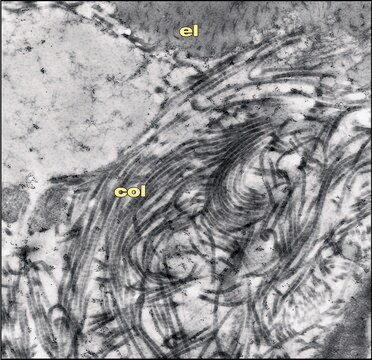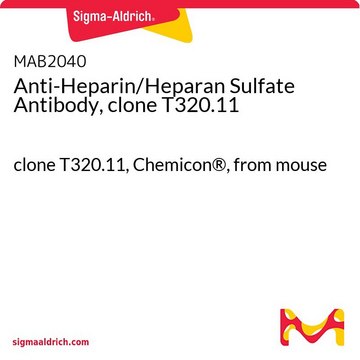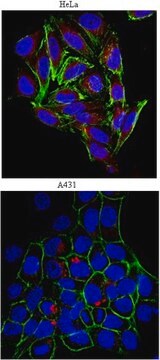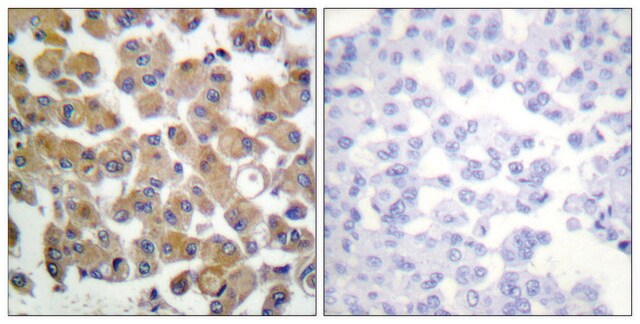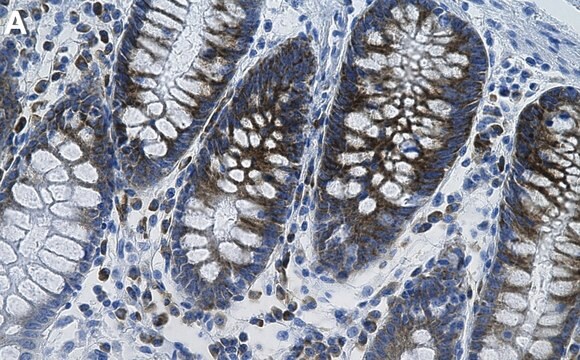MABF3163
Anti-CD44 Antibody, clone HERMES-3
Sinônimo(s):
CD44 antigen, CDw44, ECMR-III, Epican, Extracellular matrix receptor III, GP90 lymphocyte homing/adhesion receptor, HUTCH-I, Heparan sulfate proteoglycan, Hermes antigen, Hyaluronate receptor, PGP-1, Phagocytic glycoprotein 1
About This Item
Produtos recomendados
fonte biológica
mouse
Nível de qualidade
forma do anticorpo
purified antibody
tipo de produto de anticorpo
primary antibodies
clone
HERMES-3, monoclonal
peso molecular
observed mol wt ~85-95 kDa
purificado por
using protein G
reatividade de espécies
mouse, human
embalagem
antibody small pack of 100
técnica(s)
ELISA: suitable
flow cytometry: suitable
immunocytochemistry: suitable
immunofluorescence: suitable
immunohistochemistry: suitable
immunoprecipitation (IP): suitable
inhibition assay: suitable
western blot: suitable
Isotipo
IgG2aκ
sequência de epítopo
Extracellular domain
nº de adesão de ID de proteína
nº de adesão UniProt
temperatura de armazenamento
-10 to -25°C
Informações sobre genes
human ... CD44(960)
Especificidade
Imunogênio
Aplicação
Evaluated by Western Blotting in Human fetal foreskin tissue lysate.
Western Blotting Analysis: A 1:500 dilution of this antibody detected CD44 in Human fetal foreskin tissue lysate.
Tested Applications
Western Blotting Analysis: A 1:500 dilution from a representative lot detected CD44 in human tonsil tissue extracts.
ELISA Analysis: A representative lot detected CD44 in ELISA applications (Torrado, E., et al. (2013). PLoS One. 8(4):e61681).
Immunocytochemistry Analysis: A representative lot detected CD44 in Immunocytometry applications (Picker, L.J., et al. (1989). J Cell Biol. 109(2):927-37).
Flow Cytometry Analysis: A representative lot detected CD44 in Flow Cytometry applications (Jalkanen, S., et al. (1987). J Cell Biol. 105(2):983-90; Zhang, N., et al. (2012). Nat Immunol. 13(7):667-73).
Inhibition Assay: A representative lot selectively inhibited lymphocyte binding to lymph node and mucosal high endothelial venules. (Jalkanen, S., et al. (1987). J Cell Biol. 105(2):983-90).
Immunohistochemistry Applications: A representative lot detected CD44 in Immunohistochemistry applications (Huang, Z., et al. (2014). J Immunol.;192(11):5285-95).
Western Blotting Analysis: A representative lot detected CD44 in Western Blotting applications (Picker, L.J., et al. (1989). J Immunol. 142(6):2046-51; Picker, L.J., et al. (1989). J Cell Biol. 109(2):927-37).
Immunofluorescence Analysis: A representative lot detected CD44 in Immunofluorescence applications (Huang, Z., et al. (2014). J Immunol.; 92(11):5285-95).
Immunoprecipitation Analysis: A representative lot detected CD44 in Immunoprecipitation applications (Jalkanen, S., et al. (1987). J Cell Biol. 105(2):983-90).
Note: Actual optimal working dilutions must be determined by end user as specimens, and experimental conditions may vary with the end user.
Descrição-alvo
forma física
Reconstituição
Armazenamento e estabilidade
Outras notas
Exoneração de responsabilidade
Não está encontrando o produto certo?
Experimente o nosso Ferramenta de seleção de produtos.
Código de classe de armazenamento
12 - Non Combustible Liquids
Classe de risco de água (WGK)
WGK 2
Ponto de fulgor (°F)
Not applicable
Ponto de fulgor (°C)
Not applicable
Certificados de análise (COA)
Busque Certificados de análise (COA) digitando o Número do Lote do produto. Os números de lote e remessa podem ser encontrados no rótulo de um produto após a palavra “Lot” ou “Batch”.
Já possui este produto?
Encontre a documentação dos produtos que você adquiriu recentemente na biblioteca de documentos.
Nossa equipe de cientistas tem experiência em todas as áreas de pesquisa, incluindo Life Sciences, ciência de materiais, síntese química, cromatografia, química analítica e muitas outras.
Entre em contato com a assistência técnica
